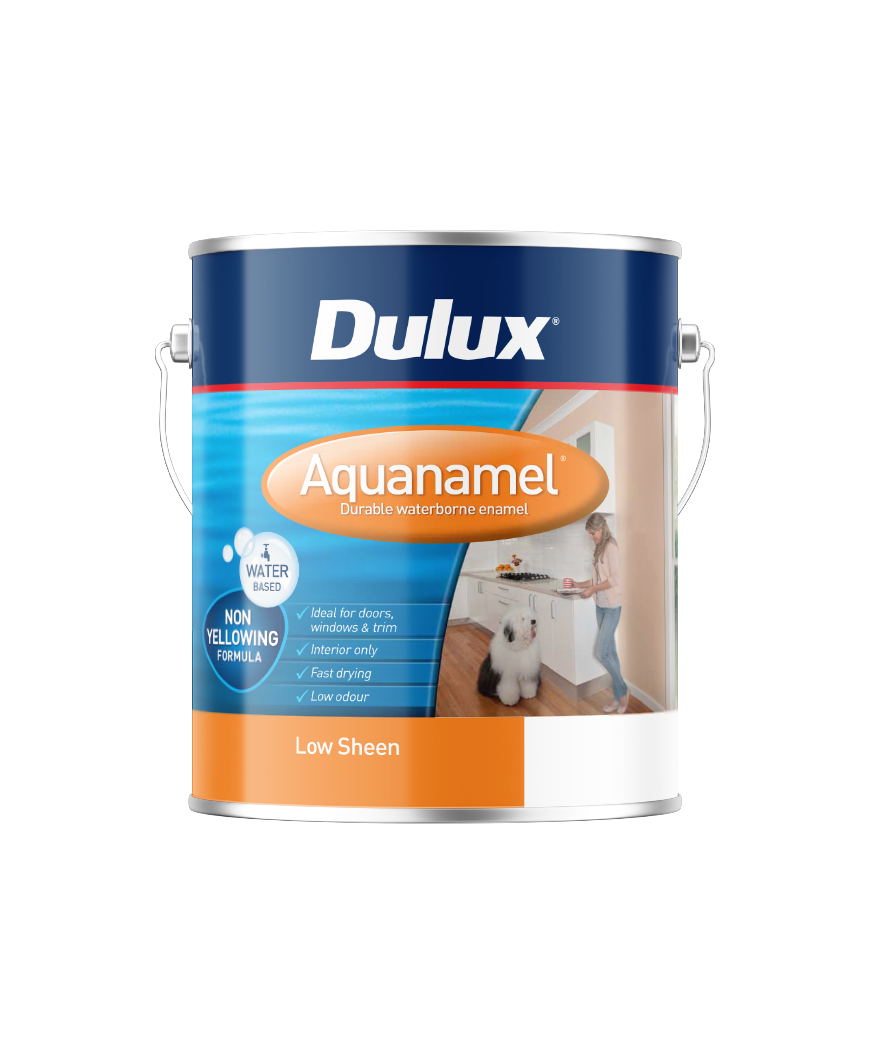Aquanamel® Low Sheen

About Aquanamel® Low Sheen
Dulux Aquanamel® Low Sheen is a premium quality water-based interior acrylic enamel that dries to a tough finish. This product is so resistant that common marks are able to be removed with common household cleaners.
It resists knocking, chipping and yellowing and is highly recommended for doors, architraves, timber trim, walls and skirting boards as an alternative to traditional, oil-based enamels.
Downloads
Application
At a glance
- Non-yellowing
- Water clean up
- Quick-drying
- Complies with Green Star New Zealand rating requirements
- Made in New Zealand
- Eco Choice Aotearoa approved (License No: 705019)
Areas to use
Previously Painted Surfaces
Surface must be clean, dry and free from dust, oils and grease.
Previously painted surfaces in good condition:
• Dust
• Clean with Selleys® Sugar Soap.
Previously painted surfaces with cracks or holes repaired with filler:
• Spot primer repairs with Dulux 1Step® Prep Water Based Primer, Sealer & Undercoat.
Glossy surfaces:
• Lightly sand to a dull finish.
• Then apply Dulux 1Step® Prep Water Based Primer, Sealer & Undercoat.
Unpainted Surfaces
Surface must be clean, dry and free from dust, oils and grease.
Unpainted plasterboard, brick, cement board, timber:
• Apply one coat of Dulux 1Step® Prep Water Based Primer, Sealer & Undercoat.
Unpainted set plaster, fibrous plaster, plaster glass:
• Apply one coat of Dulux PRECISION® Sealer Binder.
Unpainted steel/wrought iron:
• Remove rust.
• Apply one coat of Dulux 1Step® Oil-Based Primer, Sealer & Undercoat.
Brush, roller
Stir contents thoroughly before and during use with a broad flat stirrer using an upward lifting action.
Apply two coats of Dulux Aquanamel® Low Sheen ensuring that the first coat is completely dry before applying the second.
Thinning is not normally required, but if the conditions are hot and windy, up to 50mL per litre of Dulux Hot Weather Thinners may be added to ease application.
Brush or roller:
• Apply a full even coat direct from the can.
• Wet brushes and rollers with water before commencing application.
• Avoid excessive brushing or rolling back into the paint that has been drying for more than three minutes.
Poor quality or worn brushes and rollers can affect the final finish achieved.
Airless/Conventional Spray
Up to 100mL per litre of water may be added for application by conventional spray and up to 30mL per litre of water for airless spray to aid atomisation.
Unused paint
Do not pour leftover paint down the drain.
Unwanted paint should be brushed out on newspaper and allowed to dry, and then disposed of via domestic waste collections.
For more information on responsible disposal of paint and packaging visit paintback.com.au or painttakeback.co.nz
For more information visit painttakeback.co.nz
Empty paint containers
Leave empty paint containers open in a well-ventilated area to dry out. When dry, recycle the container via steel can recycling programs.
Disposal of empty paint containers via domestic recycling programs may differ between local authorities. Check with your local council first.
Do not reuse container unless thoroughly decontaminated.
For more information on responsible disposal of paint and packaging visit paintback.com.au or painttakeback.co.nz
Shop with us when you want, how you want.
DuluxTRADE Online
Download the app to access the benefits of a DuluxTRADE account on the go.
Get detailed information about the physical and chemical properties of our products.
Advice for those challenges that arise in your busy and varied days.
Access technical product information and create project specifications.
